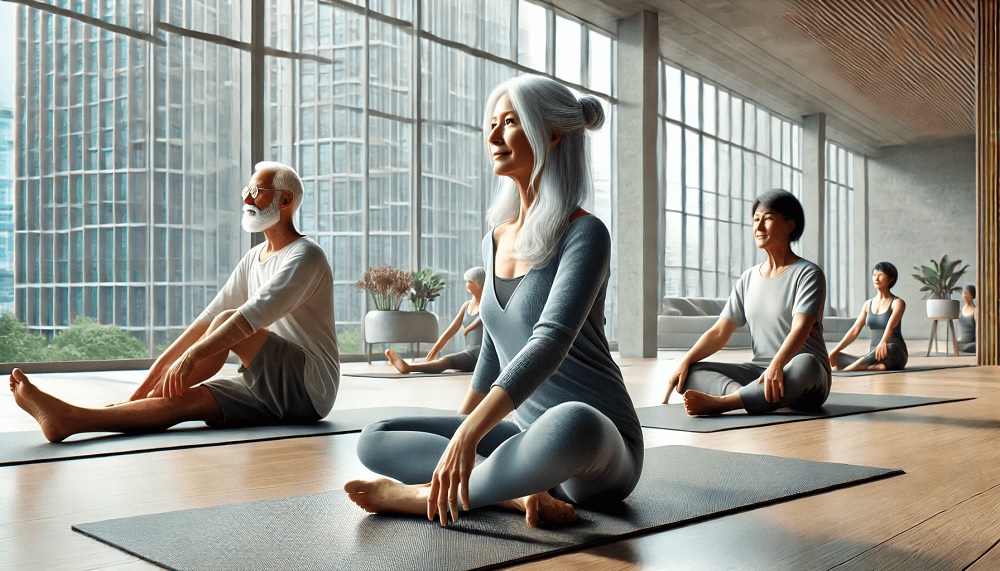Ageing gracefully is more than just a phrase—it’s a lifestyle choice. In Singapore, where life expectancy is among the highest in the world, the focus has shifted from simply living longer to living better. More seniors are turning to yoga Singapore as a practical and safe way to maintain physical mobility, emotional stability, and overall quality of life.
Yoga offers a gentle yet effective form of exercise for older adults, helping to ease joint stiffness, improve circulation, and foster mental clarity. Unlike more intense workout regimens, yoga is inclusive, low-impact, and easily adaptable, making it ideal for seniors with various fitness levels and health conditions. Whether you’re newly retired, dealing with age-related aches, or simply looking to stay active, yoga provides a structured and supported approach to ageing well.
Studios like Yoga Edition provide specialised programmes tailored to seniors, offering supportive instruction that prioritises safety, gradual progression, and individual comfort.
Why Seniors in Singapore Are Embracing Yoga
Singapore’s rapidly ageing population presents both challenges and opportunities. As of recent data, nearly one in five Singapore residents is aged 65 or older, and this number is expected to grow significantly in the next decade. With that comes an increased interest in preventive health measures that promote independence and vitality.
Yoga helps seniors by:
- Enhancing joint flexibility and muscle tone
- Supporting balance and fall prevention
- Improving respiratory function and cardiovascular health
- Reducing anxiety, depression, and cognitive decline
- Providing a social outlet and sense of community
Many seniors in Singapore find that yoga complements other health activities like walking, tai chi, or swimming, forming a balanced wellness routine that supports their long-term mobility and emotional wellbeing.
Addressing Common Health Concerns with Yoga
1. Improving Balance and Preventing Falls
Falls are a leading cause of injury among older adults in Singapore. Yoga strengthens the legs, hips, and core muscles—key areas responsible for maintaining stability. Through balance-focused poses like tree pose or warrior III (with modifications), seniors build awareness of body alignment, improving their posture and reaction time.
2. Managing Joint Pain and Arthritis
Conditions like osteoarthritis and joint stiffness can make traditional workouts difficult. Yoga’s slow, controlled movements increase circulation and lubricate joints, reducing inflammation and easing discomfort. Poses such as cat-cow, seated twists, and supported forward folds provide gentle mobilisation without overexertion.
3. Supporting Heart Health and Blood Pressure
Yoga’s calming effect on the nervous system lowers stress hormones like cortisol, which can contribute to hypertension and heart issues. Deep breathing practices (pranayama) and gentle inversions can help regulate blood pressure while boosting circulation.
4. Enhancing Mental Sharpness
Mental decline is a major concern for many older adults. Yoga enhances concentration and memory by encouraging mindfulness and sustained mental engagement. Meditation and focused breathwork improve neuroplasticity, helping seniors remain mentally agile and emotionally resilient.
Types of Yoga Best Suited for Seniors
While yoga is generally adaptable, certain styles are more beneficial and comfortable for older individuals, especially beginners or those managing medical conditions.
Chair Yoga
Perfect for those with limited mobility or balance issues. Most postures are done seated or using a chair for support. This practice promotes circulation, improves joint range, and engages muscles safely.
Gentle Hatha Yoga
A slow-paced practice that focuses on foundational poses, breathing, and relaxation. Great for improving strength, flexibility, and coordination without straining the body.
Yin Yoga
Targets deep connective tissues through long-held, passive stretches. Yin is beneficial for joint health and helps seniors cultivate stillness and patience.
Restorative Yoga
Ideal for stress relief and deep rest, this style uses props like bolsters and blankets to support the body in restful poses. Especially useful for seniors recovering from illness or injury.
Each of these styles can be safely practised with proper guidance and the use of props, which many studios in Singapore provide as part of their senior-focused classes.
Customising Yoga Practice for Ageing Bodies
As with any physical activity, safety is paramount for seniors practising yoga. Instructors in Singapore often adjust poses based on the individual’s range of motion, strength, and health history.
Here’s how classes are often customised:
- Props and supports: Use of yoga blocks, bolsters, straps, and chairs for added safety and ease
- Shorter sequences: Classes may last 45–60 minutes to match energy levels and concentration
- Longer warm-ups and cool-downs: Prepares the body and prevents injury
- Avoiding pressure points: Certain postures that place weight on wrists, knees, or neck are either modified or avoided
It’s important for seniors to inform instructors about any medical conditions, recent surgeries, or areas of pain so that appropriate modifications can be given.
Building Confidence and Social Connection
Aside from physical benefits, yoga classes for seniors provide a valuable sense of community. Many older adults in Singapore face social isolation after retirement, bereavement, or lifestyle changes. Group yoga classes foster positive interactions, shared experiences, and a space where seniors can feel heard, supported, and encouraged.
Some studios even offer tea and conversation sessions post-class, turning yoga into a weekly highlight rather than just a physical practice. The emotional boost that comes from feeling part of a group contributes significantly to overall mental health.
Tips for Seniors New to Yoga in Singapore
- Start slow: Begin with one class per week and gradually increase frequency
- Wear comfortable clothing: Avoid tight-fitting outfits and opt for breathable fabrics
- Listen to your body: Pain is not part of yoga; always stop if something feels wrong
- Stay hydrated: Especially in Singapore’s humid climate, water intake before and after class is key
- Consult your doctor: Particularly if you have chronic conditions like heart disease or osteoporosis
Many studios offer trial classes or senior-specific schedules, making it easy for newcomers to explore their options without pressure.
FAQ
Q: I’ve never done yoga before. Can I still start at 60 or older?
A: Absolutely. Yoga is for all ages. Many seniors in Singapore begin yoga in their 60s or 70s and enjoy years of benefits. Start with beginner or senior-specific classes where instructors can guide you safely.
Q: Will yoga help with my arthritis or knee pain?
A: Yes. Gentle movements and proper alignment in yoga help reduce joint stiffness and improve flexibility. However, it’s important to avoid any postures that put excessive pressure on the knees and to work closely with experienced instructors.
Q: Are online yoga classes suitable for seniors?
A: They can be, especially for those who are homebound. However, in-person classes offer more supervision and immediate support. If joining online, choose beginner-level videos from qualified local instructors.
Q: Is it safe to do yoga after hip or knee replacement?
A: Many seniors return to yoga post-surgery, but modifications are necessary. Always get clearance from your doctor and inform your instructor about your surgery so they can adjust the practice accordingly.
Q: Do I need to bring my own mat and props?
A: Most studios in Singapore provide mats and props, especially for senior classes. You can bring your own for hygiene or comfort, but it’s not a requirement.










